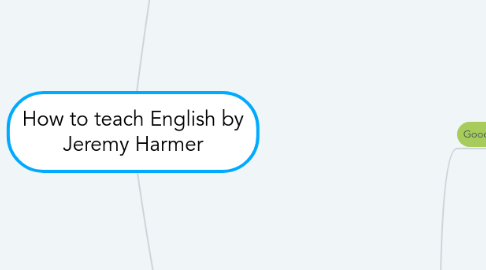
1. Learners
1.1. Reasons for learning
1.1.1. Specific Purpose (ESP)
1.1.1.1. Businness, Tourism, Banking, among others.
1.1.2. Academic Purposes (EAP)
1.2. Contexts
1.2.1. English as a Foreign Language
1.2.1.1. Those students who want to learn to use language for traveling or communication with people from another countries.
1.2.2. English as a Second Language
1.2.2.1. Students who are living in the target language community
1.2.3. English for Speakers of other Languages
1.2.3.1. Students who are involved in EFL and ESL at the same time.
1.3. Learners and their differences
1.3.1. Age
1.3.1.1. Students' interest and skills to learn can be affected based on their age. Children learn in a different way than Adolescents do. The same happen with Adults.
1.3.1.1.1. Teachers need to take this into account when preparing classes.
1.3.2. Learning Styles
1.3.2.1. All students have different skills, as well as strenghts and weaknesses.
1.3.2.1.1. Multiple Intelligences (mathematical, musical, interpersonal, spatial, emotional, etc) have to be taken into account for every student when creating a lesson plan.
1.3.3. Levels
1.3.3.1. Beginners
1.3.3.1.1. A1, A2
1.3.3.2. Intermediate
1.3.3.2.1. B1, B2
1.3.3.3. Upper intermediate
1.3.3.3.1. B2,C1
1.3.3.4. Advanced
1.3.3.4.1. C2
1.3.4. Educational and Cultural background
1.3.4.1. Some cultures value education a litttle bit more than others. This can influence a lot the students' motivation, responses, tasks, and others
1.4. Motivation
1.4.1. Extrinsic
1.4.1.1. Motivation that students bring into the classroom from outside
1.4.2. Instrinsic
1.4.2.1. Motivation that is generated inside the classroom. Can be generated by teacher's methods and activities during the lessons.
1.5. Responsability
1.5.1. Every student is responsible for their own learning process, however, teachers may influence in this.
1.5.1.1. Teachers may provide support by providing websites with information and activities related to the topics presented during class
1.5.1.2. Teachers can ask students to do various kinds of activities, such as homeworks, written exercises, and others
1.5.1.3. Teachers can provide resources so Students can work at home, such as newspapers, magazines, worksheets, listening material, videos and DVDs
2. Teachers
2.1. Good teachers
2.1.1. Passionate about their job
2.1.2. Dinamic
2.1.3. Good attitude
2.1.4. Make lessons interesting
2.1.5. Respectful
2.2. Teachers' role
2.2.1. Controller
2.2.2. Prompters
2.2.2.1. By encouraging students and pushing them to achieve more
2.2.3. Assessors
2.2.3.1. Providing students with grades, and a basic analysis of their performance
2.2.4. Resource
2.2.4.1. Be able to provide assistance and a response for students and their questions
2.3. Rapport
2.3.1. Relationship between students and teacher
2.3.1.1. This can be influenced by
2.3.1.1.1. Recognising students and their effort
2.3.1.1.2. Listening to Students
2.3.1.1.3. Respecting Students
2.3.1.1.4. Being even handed and equal towards everyone
2.4. Teachers' tasks
2.4.1. Preparation
2.4.1.1. Includes materials, activities, lesson plans, and others
2.4.2. Keeping records
2.4.2.1. Taking register, filling forms, writing reports
2.4.3. Being reliable
2.4.3.1. Leading by example, being on time, and doing a good job in all aspects
2.5. Teachers' skills
2.5.1. Managing classes
2.5.2. Variety
2.5.2.1. Teachers have the skills to vary activities and topics over a period of time. This can prevent monotony, which can eventually lead to a problem of motivation.
2.5.3. Destinations
2.5.3.1. Teachers may be able to understand the purpose of the activites proposed in the classroom, and what skills students have to develop for those activities. Based on this, tteacher should be able to iddentify when a student has reached the goal, and when is the right moment to move forward into the next topic.
2.6. Teachers' knowledge
2.6.1. The language system
2.6.1.1. Teachers may have enough skills for a good speaking, writing and listening in the language.
2.6.1.1.1. Teachers should be able to resolve any concern students may have related to the target language.
2.6.2. Materials and resources
2.6.2.1. A good teacher should be able to create good materials for the lessons, as well as know how to use those materials and resources.
2.6.2.1.1. Material and resources may include workbooks, puzzles, videos, and others.
2.6.3. Clasroom equipment
2.6.3.1. Teacher needs to use different resources to be able to support his or her lessons.
2.6.3.1.1. Equipment may include the user of computers, CDs, blogs, podcasts, music, Power Point presentations, among others.
2.6.3.2. Control and organization of the class, and prevention of misbehaviour, and reacting effectively when it happens.
2.6.4. Keeping up to date
2.6.4.1. Nowadays technology offers the chance to be updated about new tools, methods and others related to teaching.
2.6.4.1.1. Teachers have to be updated about all these things in order to provide students with good and updated information.
